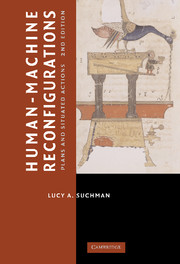Book contents
- Frontmatter
- Contents
- Acknowledgments
- Preface to the 2nd Edition
- Introduction
- 1 Readings and Responses
- 2 Preface to the 1st Edition
- 3 Introduction to the 1st Edition
- 4 Interactive Artifacts
- 5 Plans
- 6 Situated Actions
- 7 Communicative Resources
- 8 Case and Methods
- 9 Human–Machine Communication
- 10 Conclusion to the 1st Edition
- 11 Plans, Scripts, and Other Ordering Devices
- 12 Agencies at the Interface
- 13 Figuring the Human in AI and Robotics
- 14 Demystifications and Reenchantments of the Humanlike Machine
- 15 Reconfigurations
- References
- Index
- Frontmatter
- Contents
- Acknowledgments
- Preface to the 2nd Edition
- Introduction
- 1 Readings and Responses
- 2 Preface to the 1st Edition
- 3 Introduction to the 1st Edition
- 4 Interactive Artifacts
- 5 Plans
- 6 Situated Actions
- 7 Communicative Resources
- 8 Case and Methods
- 9 Human–Machine Communication
- 10 Conclusion to the 1st Edition
- 11 Plans, Scripts, and Other Ordering Devices
- 12 Agencies at the Interface
- 13 Figuring the Human in AI and Robotics
- 14 Demystifications and Reenchantments of the Humanlike Machine
- 15 Reconfigurations
- References
- Index
Summary
Marginal objects. objects with no clear place, play important roles. On the lines between categories, they draw attention to how we have drawn the lines. Sometimes in doing so they incite us to reaffirm the lines, sometimes to call them into question, stimulating different distinctions.
(Turkle 1984: 31)In The Second Self (1984), Sherry Turkle describes the computer as an evocative object, one that raises new questions regarding our common sense of the distinction between artifacts and intelligent others. Her studies include an examination of the impact of computer-based artifacts on children's conceptions of the difference between categories such as “alive” versus “not alive” and “machine” versus “person.” In dealing with the questions that computer-based objects evoke, children make clear that the differentiation of physical from psychological entities, which as adults we largely take for granted, is the end product of a process of establishing the relationship between the observable behavior of a thing and its underlying nature. Children have a tendency, for example, to attribute life to physical objects on the basis of behaviors such as autonomous motion or reactivity, though they reserve humanity for entities evidencing such things as emotion, speech. and apparent thought or purposefulness. Turkle's observation with respect to computational artifacts is that children ascribe to them an “almost aliveness” and a psychology, while maintaining their distinctness from human beings: a view that, as Turkle points out, is remarkable among other things for its correspondence to the views held by those who are the artifacts' designers.
- Type
- Chapter
- Information
- Human-Machine ReconfigurationsPlans and Situated Actions, pp. 33 - 50Publisher: Cambridge University PressPrint publication year: 2006
- 1
- Cited by



